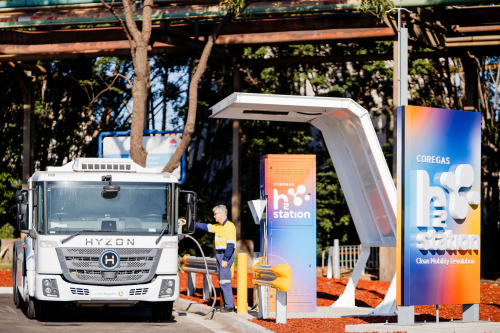While battery electric vehicles will drive decarbonization of road transport in Australia, there are opportunities for hydrogen-powered vehicles to play a significant role with long-haul travel and freight transport, the report says.

Hydrogen-powered vehicle refueling at Coregas station located in Port Kembla, NSW.
Hydrogen-powered vehicles are quicker to refuel, have a greater range between refuelling stops and can maximize their payload because they don’t need to carry large, heavy batteries required by electric vehicles.
The ‘Hydrogen vehicle refuelling infrastructure’ report sets out the opportunities and challenges for deploying refueling stations for hydrogen-powered road vehicles in Australia.
CSIRO’s chief scientist, Prof Bronwyn Fox, said Australia needs to urgently decarbonize its transport sector, which currently accounts for 18.6% of the country’s greenhouse gas emissions, if the country is to meet its net zero commitments. Heavy vehicles are a key contributor to these emissions.
While we know hydrogen will play a critical role, we also know that much of the key infrastructure for storing, moving and distributing hydrogen for use as a transport fuel—including pipelines, storage tanks and refueling stations—is yet to be built. That’s why this report is so important. It identifies priorities for action, including areas that would benefit from targeted research and innovation.
—Prof Fox
The report compared the different hydrogen storage and dispensing options available, and evaluated refueling infrastructure options based on fuel demand and distance from the hydrogen source.
Key findings from the report include:
While all Australian hydrogen refueling stations currently have onsite hydrogen production, centralized offsite production and distribution of hydrogen is likely to be the dominant future model, due to cost efficiencies with scale and not needing to accommodate onsite production when selecting sites.
Partnerships and consortia are a successful approach to building hydrogen vehicle refueling infrastructure. In the more developed hydrogen economies in Europe, the US and Japan, businesses and government organizations are partnering in hydrogen infrastructure development projects to pool resources, and share costs and risk.
Liquefaction, and transport and storage of liquid hydrogen to be dispensed as a gas, presents as an opportunity to greatly improve distribution and storage capacities. However, transport and storage of liquid hydrogen at low volumes is currently very expensive compared to compressed hydrogen.
Transport of hydrogen directly to refueling stations by dedicated pipeline will likely be difficult to justify, due to high capital intensity and relatively low demand of individual refuellers. There may be refueling locations in industrial or port areas that are suitable for direct pipelines, due to proximity to the supply source or having pre-existing pipelines that can be repurposed.
Shawn Wolfe, Executive Advisor at GHD Advisory and lead author of the report, said Australia currently has only five hydrogen refueling stations in operation, with 20 planned or under construction.
The pace of the transition to hydrogen-powered transport is moving a lot faster internationally than in Australia. Companies like Daimler and Ampol are not hedging their bets—it’s a hydrogen and electric transport future. We need to get into lockstep or risk being left behind.
—Shawn Wolfe
Dr Patrick Hartley, Leader of CSIRO’s Hydrogen Industry Mission, said research is happening at every point of the hydrogen supply chain, from hydrogen production through to storage, distribution and ultimately utilization technologies like fuel cells.
Australia is unique in terms of our size and sparse distribution of population, so finding ways to make hydrogen available across the continent will be a key enabler. This report will help regulators and industry stakeholders understand where they can best focus their activities and progress their plans to develop infrastructure for hydrogen-powered transport.
—Dr Hartley